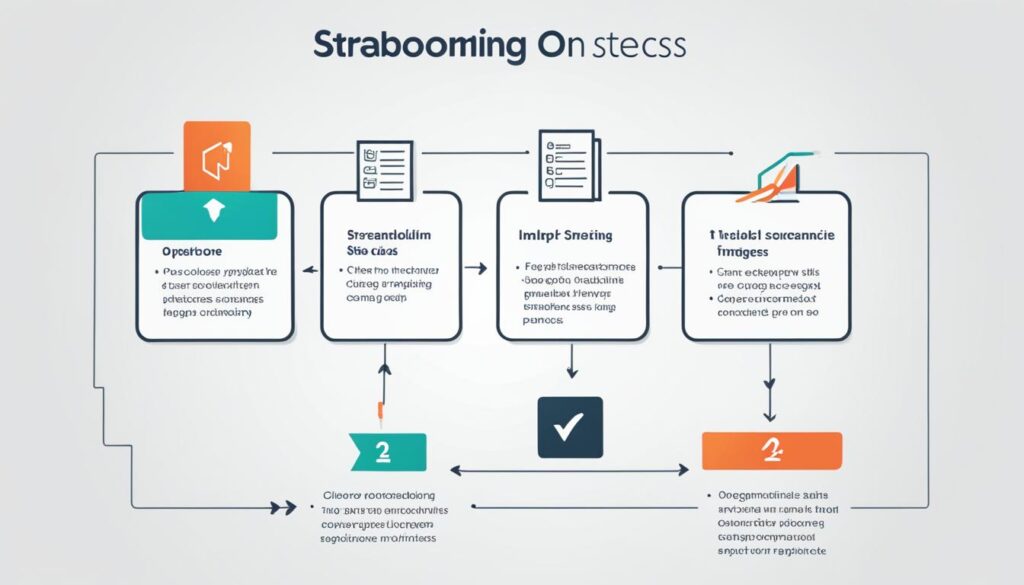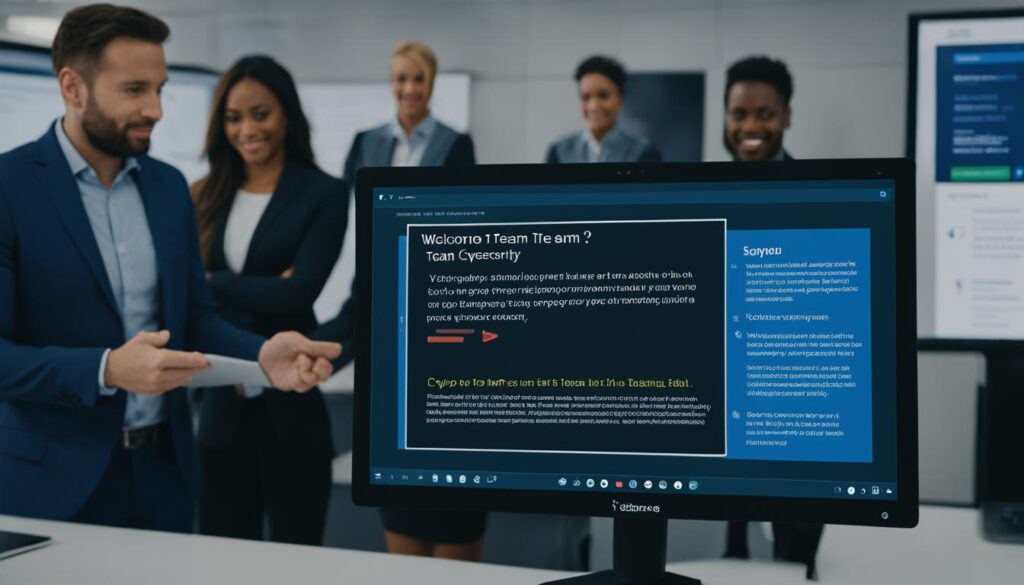Welcome to the world of employee onboarding, where the success and productivity of your new hires begin. A smooth and efficient onboarding process is crucial for not only providing a positive experience to your employees but also ensuring their long-term engagement and retention in your organization. By streamlining your onboarding process, you can set the stage for a successful journey from day one.
Streamlined employee onboarding is all about creating an efficient and effective process that maximizes productivity and minimizes the time and effort required from both HR professionals and new hires. By implementing automated employee onboarding techniques and adopting effective employee onboarding strategies, you can simplify administrative tasks, accelerate training and integration, and enhance the overall onboarding experience.
Key Takeaways:
- A streamlined onboarding process improves employee experience, retention, and engagement.
- Efficient onboarding showcases the company’s commitment to employee development and well-being.
- Strategies such as pre-boarding, training plans, feedback mechanisms, and buddy programs enhance the onboarding process.
- Automated onboarding software solutions can streamline administrative tasks and improve efficiency.
- Employee orientation and onboarding are distinct processes, each with its own purpose and timeline.
The Importance of Efficient Onboarding
Efficient onboarding is crucial for creating a positive employee experience and setting the stage for long-term engagement, retention, and productivity. When organizations streamline the onboarding process, they demonstrate to new hires that their development and well-being are valued, resulting in greater employee satisfaction and loyalty.
Studies have shown that engaged employees are more productive and have lower levels of absenteeism. They are also more likely to have a long tenure with the company. By implementing modern onboarding methods and best practices, organizations can ensure a smooth and effective onboarding experience that sets employees up for success.
To streamline employee onboarding, organizations can adopt various techniques, such as:
- Utilizing technology: Incorporating digital tools and software can automate administrative tasks, simplify the onboarding process, and improve efficiency.
- Implementing a structured onboarding program: Creating a clear and comprehensive training plan tailored to each employee’s role and goals helps them acclimate to their new position efficiently.
- Providing ongoing support: Offering continuous guidance and mentoring through the use of buddy programs or mentorship initiatives helps new hires feel supported and engaged.
- Soliciting feedback: Regularly seeking input from both new hires and managers allows organizations to identify opportunities for improvement and refine their onboarding process.
- Encouraging cultural integration: Promoting company values and fostering a sense of belonging can help employees adapt quickly and align with the organization’s culture.

By prioritizing efficient employee onboarding methods and implementing best practices, organizations can enhance the onboarding experience, boost productivity, and retain top talent. Effective onboarding not only accelerates the new employee’s integration but also strengthens their commitment to the organization, leading to increased employee satisfaction and long-term success.
5 Ways to Streamline the Onboarding Process
Streamlining the employee onboarding process is essential for creating an efficient and engaging experience that sets new hires up for success. By implementing the following strategies, organizations can optimize their onboarding process and ensure a seamless transition for new employees.
1. Implement Pre-boarding
Starting the onboarding process before a new hire’s first day can help familiarize them with the company and its culture. This can include providing them with information about the company’s mission, values, and expectations, as well as introducing them to their team members in advance. Pre-boarding sets a positive tone and creates excitement for the new employee’s arrival.
2. Provide Necessary Equipment in Advance
One way to streamline the onboarding process is by providing all the necessary equipment and resources to new hires before their first day. This ensures that they have everything they need to hit the ground running and minimizes any unnecessary delays or logistical issues. By being proactive in setting up workstations and providing access to software and tools, organizations demonstrate their commitment to a smooth onboarding experience.
3. Create a Clear Training Plan
A well-structured and tailored training plan is crucial for helping new hires understand their roles and responsibilities. By outlining specific learning objectives and milestones, organizations can guide employees through their onboarding journey. This may include assigning mentors or trainers who can provide ongoing support and guidance. A clear training plan helps new employees build confidence and competence in their new roles, contributing to a more efficient onboarding process.
4. Ask for Feedback
An efficient onboarding process is a continuous improvement process. By seeking feedback from both new hires and managers, organizations can identify areas of improvement and refine their onboarding strategies. Regular check-ins, surveys, and open communication channels provide opportunities for new employees to express their concerns, ask questions, and provide suggestions. This feedback loop helps organizations enhance the onboarding experience and address any challenges or gaps promptly.
5. Implement a Buddy Program
Pairing new hires with experienced employees or mentors can significantly enhance the onboarding process. Buddies provide additional support, guidance, and an avenue for new employees to ask questions and seek advice. This peer-to-peer connection helps new hires navigate the organization more effectively, fosters a sense of belonging, and accelerates their integration into the team. Implementing a buddy program contributes to a smoother and more efficient onboarding experience.

Utilizing onboarding software solutions can further automate and streamline various administrative tasks throughout the onboarding process. From digitizing paperwork to managing training modules, onboarding software offers a centralized platform that enhances organization, efficiency, and scalability.
By implementing these strategies and leveraging onboarding software solutions, organizations can streamline their employee onboarding process, creating an engaging, efficient, and successful experience for new hires from day one.
The Role of HR in Onboarding
HR plays a crucial role in ensuring the success of the onboarding process. As the dedicated department responsible for managing human resources, HR professionals are entrusted with the task of seamlessly integrating new hires into the organization. With their expertise, HR teams contribute significantly to shaping an efficient employee onboarding process.
Efficiency is key when it comes to onboarding new employees. HR teams require access to technological tools and support that automate various onboarding processes. By leveraging automated employee onboarding solutions, HR professionals can eliminate manual and time-consuming administrative tasks. This automation empowers HR teams to focus on what matters most – providing a positive and engaging onboarding experience.
Automated employee onboarding streamlines the process, allowing HR professionals to allocate their time and resources more efficiently. By harnessing the power of technology, HR teams can simplify tasks such as paperwork processing, document organization, and data management. This not only improves overall efficiency but also ensures accuracy and compliance.
Moreover, an efficient onboarding process positively impacts both the new employee and the hiring manager. By reducing administrative burdens, HR professionals can dedicate more time to fostering a welcoming environment and addressing the needs of new hires. This, in turn, facilitates a smoother transition for individuals entering the organization and enhances their overall onboarding experience.
By taking advantage of automated employee onboarding, HR professionals can create a streamlined process that combines technology and human touchpoints. This approach not only saves time and resources but also enhances efficiency, eliminates redundancy, and minimizes errors. Ultimately, it contributes to building a strong foundation for a successful employee journey within the organization.
Benefits of Automated Employee Onboarding:
- Efficient utilization of HR resources
- Reduction in administrative tasks and paperwork
- Enhanced accuracy and compliance
- Faster onboarding process
- Improved communication and engagement
The Difference Between Employee Orientation and Onboarding
Employee orientation and onboarding are two terms often used interchangeably, but they actually have distinct differences.
Employee orientation is a short-term process that typically occurs within the first few days or weeks of employment. Its main focus is to introduce new hires to the company’s policies, procedures, and culture. During orientation, employees learn about the company’s mission, vision, and values, as well as the general expectations and guidelines they need to follow.
On the other hand, onboarding is a more comprehensive and ongoing process that extends beyond the initial orientation period. It involves the systematic integration of new hires into their roles, providing them with the necessary training, support, and resources for long-term success. Unlike orientation, which tends to be more standardized, onboarding is tailored to the specific needs and goals of each employee.
Successful employee onboarding goes beyond merely introducing new hires to the company; it aims to ensure that they feel welcomed, supported, and empowered to contribute from day one. By providing a streamlined employee onboarding process, organizations can increase efficiency, productivity, and overall employee satisfaction.
Streamlined employee onboarding is crucial for organizations looking to achieve these goals. It helps new hires quickly and effectively acclimate to their new roles, reduces time spent on administrative tasks, and enhances the overall employee experience. Investing in a successful onboarding process demonstrates the organization’s commitment to its employees and sets the stage for long-term engagement and retention.
By understanding the differences between employee orientation and onboarding, organizations can ensure they have both an efficient orientation process and a comprehensive onboarding program in place. By combining the two, organizations can create a seamless transition for new employees, setting them up for success and fostering a positive and productive work environment.
Conclusion
In today’s fast-paced business environment, organizations must prioritize a streamlined employee onboarding process to unlock the full potential of their new hires. By implementing strategic measures such as pre-boarding, equipping new employees with the necessary tools, creating a well-defined training plan, soliciting feedback, and establishing a buddy program, companies can foster an efficient and engaging onboarding experience.
However, technology can play a critical role in further enhancing this process. By leveraging onboarding software solutions, organizations can automate administrative tasks, streamline workflows, and ensure a seamless onboarding experience. This not only saves time and effort but also allows HR professionals to focus on providing personalized support and guidance to new employees.
By prioritizing a streamlined employee onboarding process, organizations can boost productivity, improve employee retention, and create a positive and successful onboarding experience for new hires. Investing in the right tools and strategies sets the foundation for a productive and engaged workforce, ultimately contributing to the overall success of the company.
FAQ
What is the importance of efficient onboarding?
Efficient onboarding is essential for creating a positive employee experience and sets the stage for long-term engagement, retention, and productivity.
What strategies can organizations implement to streamline the onboarding process?
Organizations can implement strategies such as pre-boarding, providing necessary equipment in advance, creating a clear training plan, asking for feedback, implementing a buddy program, and utilizing onboarding software solutions.
What is the role of HR in the onboarding process?
HR plays a crucial role in ensuring the smooth integration of new hires into the organization by leveraging technology and support, automating the onboarding process, and providing a positive onboarding experience.
What is the difference between employee orientation and onboarding?
Employee orientation focuses on introducing new hires to the company’s policies, procedures, and culture within the first few days or weeks, while onboarding is a more comprehensive and ongoing process that includes training and support for long-term success.
How can organizations create a successful onboarding experience?
Organizations can streamline their onboarding process by implementing strategies such as pre-boarding, providing necessary equipment, creating a clear training plan, asking for feedback, and implementing a buddy program. Leveraging technology and automation through onboarding software solutions can further enhance the process.




